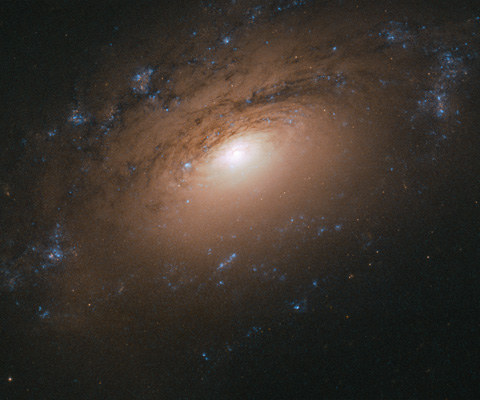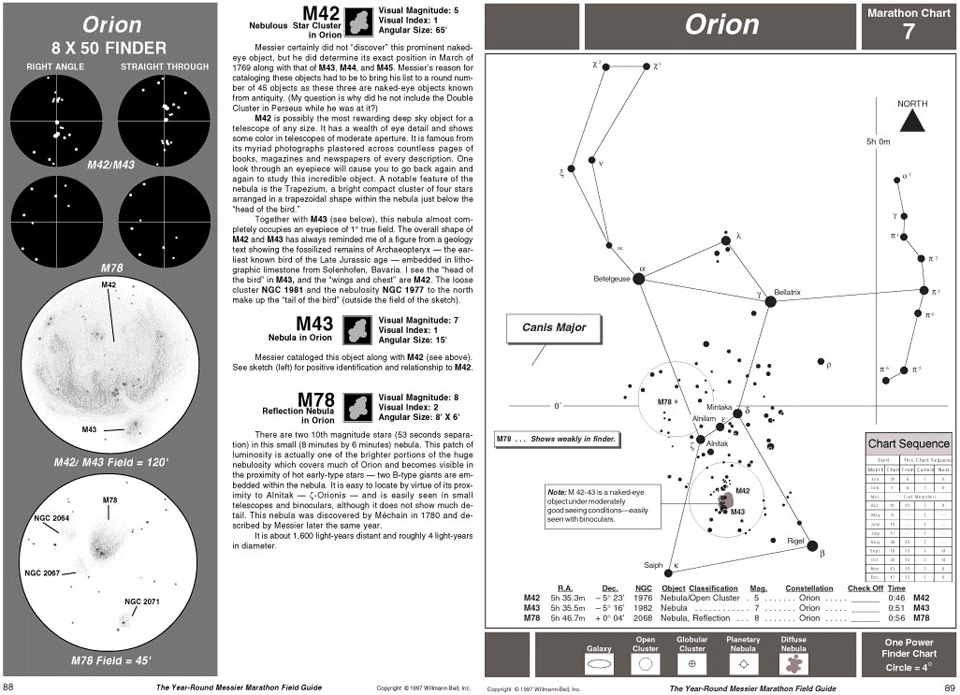Introduction
By no means complete, February’s mini guide that follows provides notes for exploring various interesting deep sky objects (DSOs) and lists other items of interest useful to the amateur astronomer.
Entries can be interpreted based on designation, description and magnitude as follows.
Designation – Description – Magnitude:
★ Telescopes 10-inch aperture minimum.
★★ Telescopes 6-inch to 9-inch aperture.
★★★ Binoculars (50mm+ aperture) and telescopes
3-inch to 5-inch aperture.
A collimated instrument, favourable atmospheric conditions, dark skies and dark-adapted eyes are assumed.

NGC 3169 galaxy. Credit: ESA/Hubble & NASA, L. Ho
About NGC 3169 galaxy
Every now and then, the NASA/ESA Hubble Space Telescope glimpses a common object — say, a spiral galaxy — in an interesting or unusual way. A sharply angled perspective, such as the one shown in this Picture of the Week, can make it seem as if we, the viewers, are craning our necks to see over a barrier into the galaxy's bright centre.
In the case of NGC 3169, this barrier is the thick dust embedded within the galaxy's spiral arms. Cosmic dust comprises a potpourri of particles, including water ice, hydrocarbons, silicates, and other solid material. It has many origins and sources, from the leftovers of star and planet formation to molecules modified over millions of years by interactions with starlight.
NGC 3169 is located about 70 million light-years away in the constellation of Sextans (The Sextant). It is part of the Leo I Group of galaxies, which, like the Local Group that houses our home galaxy, the Milky Way, is part of a larger galactic congregation known as the Virgo Supercluster.
Image credit: ESA/Hubble & NASA, L. Ho.
| February deep sky objects |
| Ursa Major constellation |
|
M81
|
Bode’s Galaxy is one of the brightest galaxies in the Messier catalogue and shares the same field of view with the M82. The galaxy is visible in binoculars. CCD cameras and large instruments will reveal two spiral arms of this face-on galaxy.
|
8.50
|
★★★
|
|
M82
|
The Cigar Galaxy is separated by 150,000 light years from the M81 and is approximately ten times smaller. Visible in binoculars the galaxy will reveal detail in instruments of 10-inch aperture and higher.
|
9.50
|
★★★
|
|
NGC3077
|
Galaxy close to the M81 with a bright nucleus.
|
10.6
|
★★
|
|
NGC2976
|
Edge-on spiral galaxy with an 8th magnitude star cluster.
|
10.9
|
★★
|
|
M97
|
The Owl Nebula is a popular target for more experienced observers. A moderate size instrument and dark skies will be required to reveal the owl’s ‘face’.
|
12.0
|
★★
|
|
NGC2820
|
Along with the NGC2814 and NGC205 the NGC2820 forms a group of galaxies within half a degree that lends itself to CCD cameras.
|
15.4
|
★
|
|
NGC2814
|
Galaxy in the NGC2814/NGC205/NGC2820 group.
|
14.3
|
★
|
|
NGC2805
|
Galaxy in the NGC2814/NGC205/NGC2820 group.
|
11.5
|
★
|
|
M108
|
A nearly edge-on galaxy without a pronounced nucleus situated just below Ursa Major and close to Merak. Larger instruments will show a long-mottled core with light and dark streaks.
|
11.0
|
★★
|
|
NGC3184
|
Bright face-on galaxy that can be easily observed with an 8-inch instrument. While visually it will appear flat, CCD long exposures will show its remarkable spiral structure.
|
10.3
|
★★
|
| Cancer constellation |
|
M44
|
The Beehive cluster is visible to the unaided eye as a faint round luminous patch. Binoculars or a small instrument and low magnifications will be required to best observe the cluster and its stars. This open cluster contains many double stars.
|
4.0
|
★★★
|
|
NGC2624
|
One of a number of small and faint galaxies in the vicinity of the M44 including the NGC2627, NGC2623 and IC2390. A minimum 10-inch aperture is recommended for these galaxies.
|
14.7
|
★
|
|
M67
|
The King Cobra is the oldest cluster known with an age of over 5 billion years. The cluster is visible through binoculars under dark skies. A 4 to 6-inch instrument will reveal the cluster’s fainter members and show the M67 at its best.
|
7.5
|
★★★
|
| Lynx constellation |
|
NGC2683
|
Near edge-on spiral galaxy.
|
9.60
|
★★
|
| Leo constellation |
|
NGC2903
|
This young barred spiral galaxy is one of the best galaxies for small scopes. It displays a halo and bright core, larger scopes will show a mottled halo with bright and dark patches.
|
9.1
|
★★★
|
| Virgo constellation |
|
NGC4216
|
This galaxy is located in the Virgo Cluster of galaxies, it has a bright core and with a number of other galaxies in the same field of view.
|
11.0
|
★★
|
| Sextants constellation |
|
NGC3115
|
The Spindle Galaxy is an edge-on galaxy that is visible through a 4-inch instrument under dark skies.
|
9.3
|
★★
|
|
NGC3169
|
Galaxy that seems to be interacting with the NGC3166. A 10-inch instrument is required to resolve the galaxies.
|
11.2
|
★★
|
|
NGC3166
|
Galaxy in the same field of view with the NGC3169 and NGC3165.
|
11.4
|
★★
|
| Hydra constellation |
|
M48
|
An open cluster of around 80 stars visible to the unaided eye. Binoculars and small instruments will show the cluster at its best.
|
5.50
|
★★★
|
|
NGC3242
|
One of the finest planetary nebulas. A small instrument will reveal a pale green/blue disk and possibly the central star. The nebula take magnification well and large scopes will reveal additional detail. CCD cameras will reveal red comet like flares on both sides of the nebula.
|
8.6
|
★★
|
|
|
Designation, Description, Magnitude
|
★ Telescopes 10-inch aperture minimum.
★★ Telescopes 6-inch to 9-inch aperture.
★★★ Binoculars (50mm+ aperture) and telescopes 3-inch to 5-inch aperture.
|
The night sky
Under excellent conditions over 2,000 stars can be seen with the unaided eye but only a few hundred of these are prominent enough to be useful in navigating the night sky, these are normally included in amateur sky maps and digital planetarium programs like the SkySafari, Stellarium, The Sky, Starry Night, Winstars 2 etc. Some stars will show colour that is useful in identifying them. For example, Antares, Betelgeuse and Aldebaran are orange/red where Vega, Rigel and Spica appear as blue/white.
Stars that form easily recognisable patterns have been given names and are referred to as constellations. Of these, the brightest stars act as beacons and can be used to effectively navigate the night sky during the different months of the year. To that extent stars can be particularly useful in locating other interesting objects nearby normally viewable through binoculars or larger instruments.
Planets and their satellites, comets and meteors move independent of the night sky background and at comparatively high speeds. They are therefore very difficult or impossible to reference to any star. However, planets like Jupiter, Saturn, Venus and Mars as well as the Moon are easy to spot with the unaided eye and in the case of the larger planets and especially the Moon, even medium size binoculars will reveal a limited degree of detail.
NGC 2683 spiral galaxy

NGC 2683 spiral galaxy. Credit: ESA/Hubble & NASA.
The NASA/ESA Hubble Space Telescope has spotted a UFO — well, the UFO Galaxy, to be precise. NGC 2683 is a spiral galaxy seen almost edge-on, giving it the shape of a classic science fiction spaceship. This is why the astronomers at the Astronaut Memorial Planetarium and Observatory gave it this attention-grabbing nickname.
While a bird’s eye view lets us see the detailed structure of a galaxy (such as this Hubble image of a barred spiral), a side-on view has its own perks. In particular, it gives astronomers a great opportunity to see the delicate dusty lanes of the spiral arms silhouetted against the golden haze of the galaxy’s core. In addition, brilliant clusters of young blue stars shine scattered throughout the disc, mapping the galaxy’s star-forming regions.
Perhaps surprisingly, side-on views of galaxies like this one do not prevent astronomers from deducing their structures. Studies of the properties of the light coming from NGC 2683 suggest that this is a barred spiral galaxy, even though the angle we see it at does not let us see this directly.
NGC 2683, discovered on 5 February 1788 by the famous astronomer William Herschel, lies in the Northern constellation of Lynx. A constellation named not because of its resemblance to the feline animal, but because it is fairly faint, requiring the “sensitive eyes of a cat” to discern it. And when you manage to get a look at it, you’ll find treasures like this, making it well worth the effort.
This image is produced from two adjacent fields observed in visible and infrared light by Hubble’s Advanced Camera for Surveys. A narrow strip which appears slightly blurred and crosses most the image horizontally is a result of a gap between Hubble’s detectors. This strip has been patched using images from observations of the galaxy made by ground-based telescopes, which show significantly less detail.
The field of view is approximately 6.5 by 3.3 arcminutes.
Image credit: ESA/Hubble & NASA.
Sky conditions
The prevailing sky conditions will have a significant effect on what you can see through any instrument and binoculars. As such if you live near a city the light pollution can make it difficult to locate and observe most DSOs. The Moon and a hazy sky will also have a negative effect.
For best results observe from a dark site and under clear transparent skies without the moon being present. Once your eyes have been accustomed to the dark conditions (this takes around 20-30 minutes) you should be able to enjoy the night sky at its best.
Filters
Filters will help to an extent and lager instruments will benefit more from them. Light pollution filters would help and photo-visual UHC (nebula filters) would be worth considering.
Printed aids
A huge number of printed aids exist in terms of deep sky maps and books. An excellent printed guide for people new in astronomy is The Year-Round Messier Marathon Field Guide published by Willmann Bell Inc.
In this large format hard-back book, the author, Harvard Pennington shows how to:
- Learn 17 bright finder stars and 17 prominent finder constellations so you will know where to look for all 110 Messier objects.
- Align a sighting device such as an 8x50 finder scope or the Telrad® so that you can point your instrument rapidly and with assurance toward all of the Messier objects.
- Calibrate your instrument so that you know exactly how much sky you see through your finder and through the eyepiece of your instrument.
- Find all of the Messier objects using the maps, drawings and descriptions in this book. You will know exactly where to point your instrument, and what the object should look like when you find it.

Extract from The Year-Round Messier Marathon Field Guide
published by Willmann Bell Inc.
Related topics:
night sky, deep sky object guide, February



